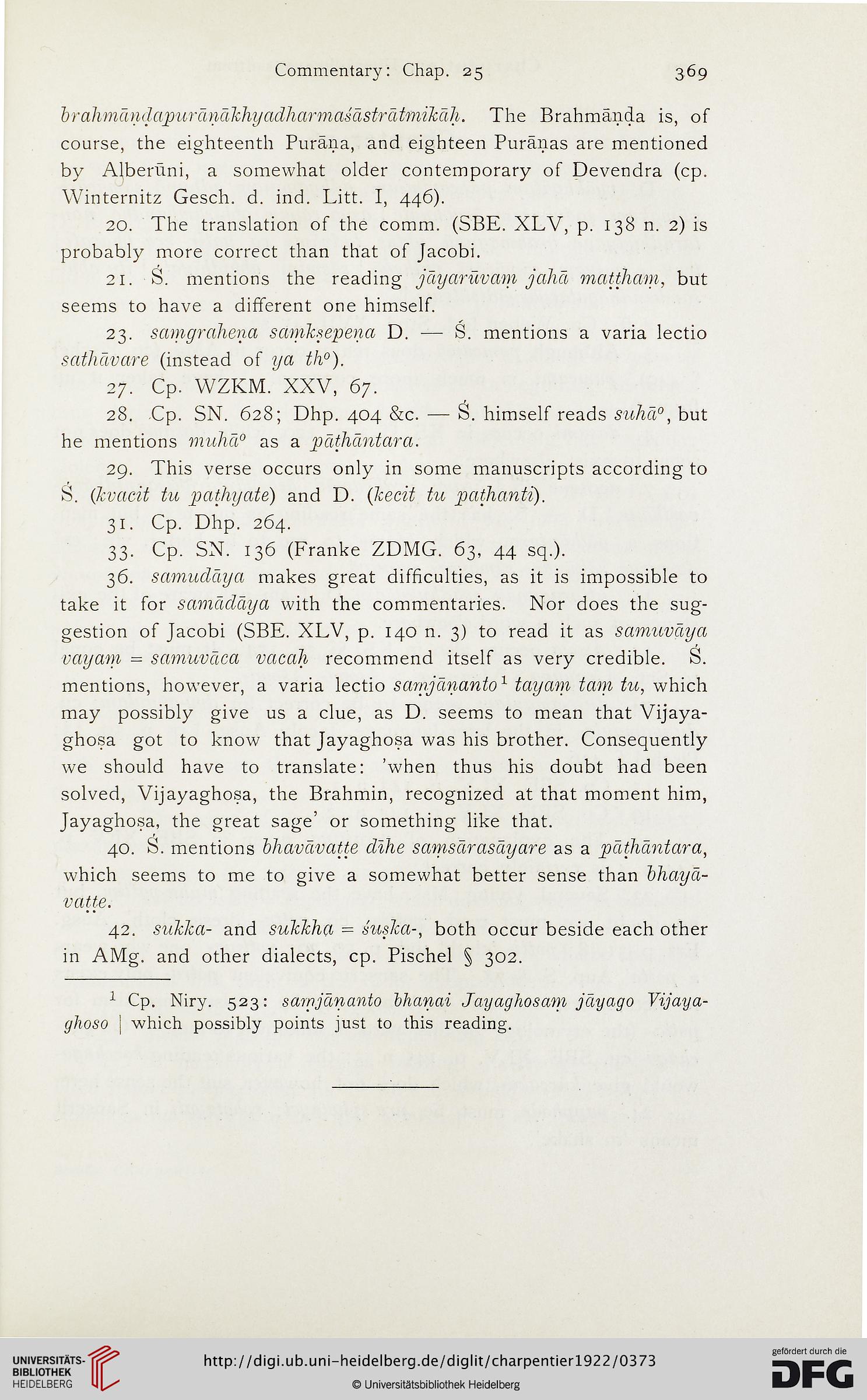Commentary: Chap. 25
369
brahmandapuranaJchyadharmasastratmikah. The Brahmanda is, of
course, the eighteenth Purana, and eighteen Puranas are mentioned
by Alberuni, a somewhat older contemporary of Devendra (cp.
Winternitz Gesch. d. ind. Litt. I, 446).
20. The translation of the comm. (SBE. XLV, p. 138 n. 2) is
probably more correct than that of Jacobi.
21. S. mentions the reading jdyaruvam jahd mcittham, but
seems to have a different one himself.
23. samgrahena scimksepena D. — S. mentions a varia lectio
sathdvare (instead of ya th°).
27. Cp. VVZKM. XXV, 67.
28. Cp. SN. 628; Dhp. 404 &c. — S. himself reads suhd0, but
he mentions muhd0 as a pdthdntara.
29. This verse occurs only in some manuscripts according to
S. (kvacit tu pathyate) and D. (kecit tu pathcmti).
31. Cp. Dhp. 264.
33. Cp. SN. 136 (Franke ZDMG. 63, 44 sq.).
36. samuddya makes great difficulties, as it is impossible to
take it for samdddya with the commentaries. Nor does the sug-
gestion of Jacobi (SBE. XLV, p. 140 n. 3) to read it as samuvciya
vayam = samuvdca vacah recommend itself as very credible. S.
mentions, however, a varia lectio sarnjdnanto1 tayam tam tu, which
may possibly give us a clue, as D. seems to mean that Vijaya-
ghosa got to know that Jayaghosa was his brother. Consequently
we should have to translate: ’when thus his doubt had been
solved, Vijayaghosa, the Brahmin, recognized at that moment him,
Jayaghosa, the great sage’ or something like that.
40. S. mentions bhavdvatte dike samscirasdyare as a pdthdntara,
which seems to me to give a somewhat better sense than bhayd-
vatte.
42. suklca- and sukkha = susJca-, both occur beside each other
in AMg. and other dialects, cp. Pischel § 302.
1 Cp. Niry. 523: sarnjdnanto bhanai Jayaghosam jdyago Vijaya-
ghoso | which possibly points just to this reading.
369
brahmandapuranaJchyadharmasastratmikah. The Brahmanda is, of
course, the eighteenth Purana, and eighteen Puranas are mentioned
by Alberuni, a somewhat older contemporary of Devendra (cp.
Winternitz Gesch. d. ind. Litt. I, 446).
20. The translation of the comm. (SBE. XLV, p. 138 n. 2) is
probably more correct than that of Jacobi.
21. S. mentions the reading jdyaruvam jahd mcittham, but
seems to have a different one himself.
23. samgrahena scimksepena D. — S. mentions a varia lectio
sathdvare (instead of ya th°).
27. Cp. VVZKM. XXV, 67.
28. Cp. SN. 628; Dhp. 404 &c. — S. himself reads suhd0, but
he mentions muhd0 as a pdthdntara.
29. This verse occurs only in some manuscripts according to
S. (kvacit tu pathyate) and D. (kecit tu pathcmti).
31. Cp. Dhp. 264.
33. Cp. SN. 136 (Franke ZDMG. 63, 44 sq.).
36. samuddya makes great difficulties, as it is impossible to
take it for samdddya with the commentaries. Nor does the sug-
gestion of Jacobi (SBE. XLV, p. 140 n. 3) to read it as samuvciya
vayam = samuvdca vacah recommend itself as very credible. S.
mentions, however, a varia lectio sarnjdnanto1 tayam tam tu, which
may possibly give us a clue, as D. seems to mean that Vijaya-
ghosa got to know that Jayaghosa was his brother. Consequently
we should have to translate: ’when thus his doubt had been
solved, Vijayaghosa, the Brahmin, recognized at that moment him,
Jayaghosa, the great sage’ or something like that.
40. S. mentions bhavdvatte dike samscirasdyare as a pdthdntara,
which seems to me to give a somewhat better sense than bhayd-
vatte.
42. suklca- and sukkha = susJca-, both occur beside each other
in AMg. and other dialects, cp. Pischel § 302.
1 Cp. Niry. 523: sarnjdnanto bhanai Jayaghosam jdyago Vijaya-
ghoso | which possibly points just to this reading.




